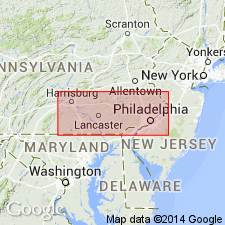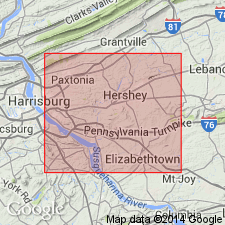
- Usage in publication:
-
- Leesport limestone*
- Modifications:
-
- Named
- Dominant lithology:
-
- Limestone
- AAPG geologic province:
-
- Appalachian basin
Summary:
Named the Leesport limestone for Leesport, Berks Co., southeastern PA. Consists generally of thin-bedded dark slaty impure limestone containing fossils of probable Trentonian age. Thickness at Leesport is 130 feet; from Hummelstown to Womelsdorf thickness is 81 feet. Unconformably overlies Beekmantown dolomite, but from Hummelstown to Womelsdorf it overlies the rocks equivalent to the Stones River. Underlies Martinsburg shale. The Leesport is of Middle Ordovician age.
Source: GNU records (USGS DDS-6; Reston GNULEX).

- Usage in publication:
-
- Leesport†
- Modifications:
-
- Abandoned
- AAPG geologic province:
-
- Appalachian basin
Summary:
Abandoned the Leesport Formation in southeastern PA. Unit is replaced by the Myerstown and Hershey Formations. Term is abandoned because exposure at type locality is structurally complex and includes rocks of the overlying Martinsburg Formation and because the authors credited for naming the Leesport (Stose and Jonas, 1927) stopped using the term in 1946.
Source: GNU records (USGS DDS-6; Reston GNULEX).
For more information, please contact Nancy Stamm, Geologic Names Committee Secretary.
Asterisk (*) indicates published by U.S. Geological Survey authors.
"No current usage" (†) implies that a name has been abandoned or has fallen into disuse. Former usage and, if known, replacement name given in parentheses ( ).
Slash (/) indicates name conflicts with nomenclatural guidelines (CSN, 1933; ACSN, 1961, 1970; NACSN, 1983, 2005, 2021). May be explained within brackets ([ ]).

